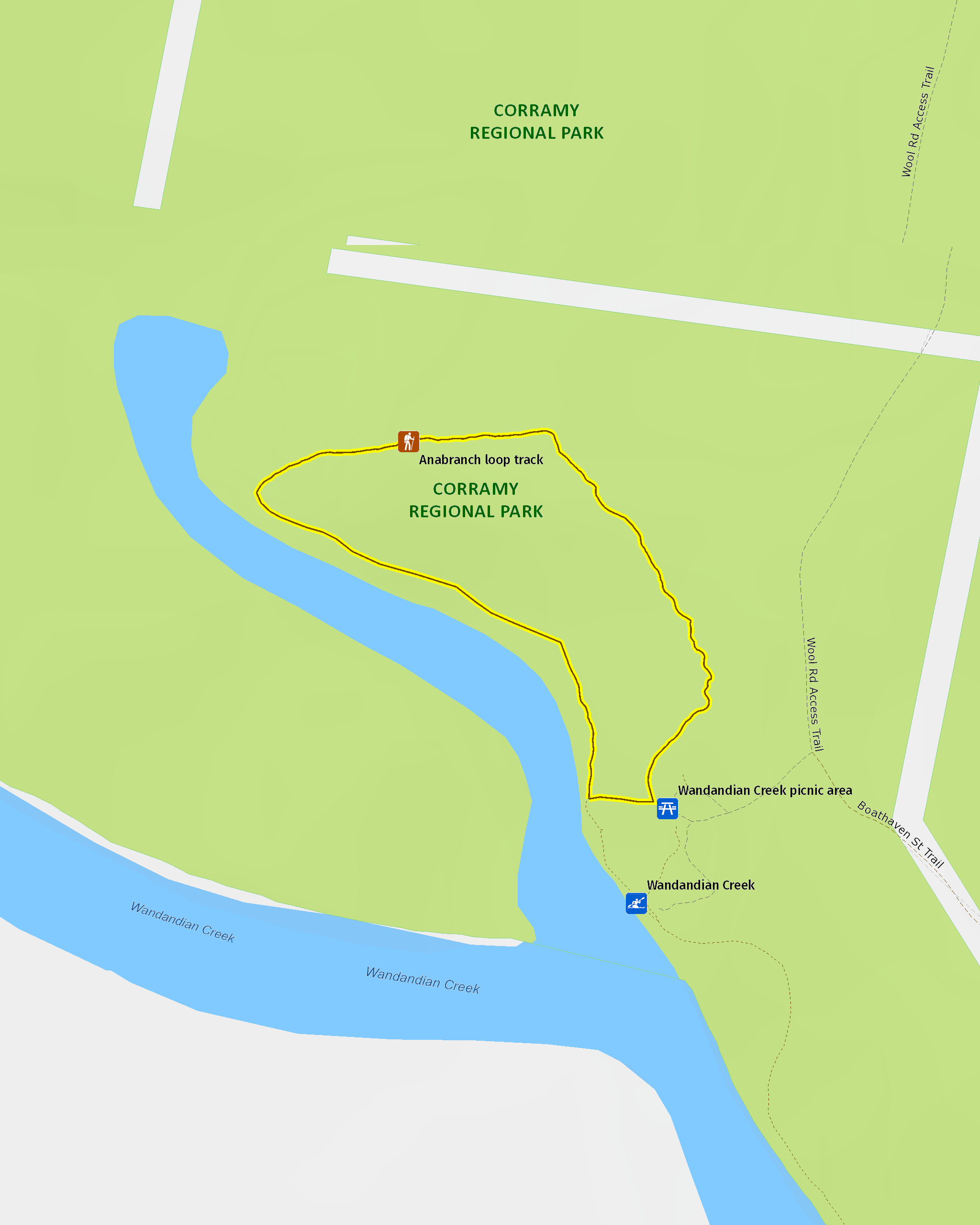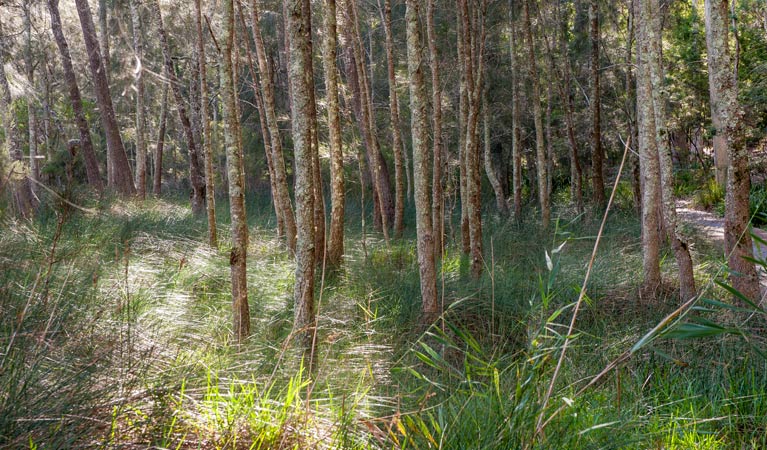Overview
Anabranch loop track is the easiest walk in Corramy Regional Park, near Nowra, passing through forest and wetland and offering close views over Wandandian Creek via a boardwalk.
- Where
- Corramy Regional Park in South Coast
- Distance
- 1km loop
- Time suggested
- 30min - 1hr
- Grade
- Grade 2
- Please note
- Strong currents and submerged hazards may be present in the creek. Take care in the water and please supervise children at all times. This area is not patrolled by lifeguards.
- A current NSW recreational fishing licence is required when fishing in all waters
- Drinking water is limited or not available in this area, so it’s a good idea to bring your own.
- There is limited mobile reception in this park
- It’s a good idea to put sunscreen on before you set out and remember to take a hat and drinking water
- Remember to take your binoculars if you want to go birdwatching
One short walk is all it takes to acquaint yourself with the best of Corramy Regional Park. Anabranch loop track twists through spotted gum forest, wetlands, and along the tranquil edge of Wandandian Creek, which is popular for fishing and kayaking. The bushland it passes is largely undisturbed, making this a terrific opportunity to enjoy unadulterated nature and the best place to start any visit to the area.
At only 1km along gentle formed track, Anabranch loop track is accessible to nearly everyone, requiring no experience though it features several steps and can be slippery after heavy rain. Closer to the creek, the track graduates onto purpose-built boardwalk, allowing you to get right near Wandandian Creek and enjoy the native birdlife.
Consider having lunch in the picnic area and then using Anabranch loop track to stretch your legs with a pair of binoculars in tow. A slightly longer and more difficult walk, Delta track, also leaves from the picnic area. Add the two together for an active day by the cool retreat of the water.
Take a virtual tour of Anabranch loop track captured with Google Street View Trekker.
Map

Map legend

Local alerts
For the latest updates on fires, closures and other alerts in this area, see https://www.nationalparks.nsw.gov.au/things-to-do/walking-tracks/anabranch-loop-track/local-alerts
General enquiries
- National Parks Contact Centre
- 7am to 7pm daily
- 1300 072 757 (13000 PARKS) for the cost of a local call within Australia excluding mobiles
- parks.info@environment.nsw.gov.au
Park info
- in Corramy Regional Park in the South Coast region
Corramy Regional Park is always open but may have to close at times due to poor weather or fire danger.
Visitor info
All the practical information you need to know about Anabranch loop track.
Track grading
Features of this track
Distance
1km loop
Time
30min - 1hr
Quality of markings
Clearly sign posted
Experience required
No experience required
Gradient
Gentle hills
Steps
Occasional steps
Quality of path
Formed track
Getting there and parking
Anabranch loop track is in the Wandandian Creek precinct of Corramy Regional Park. To get there:
- Travel south on Princes Highway from Nowra
- Turn left (east) onto The Wool Road, just north of Bewong.
- Turn right (south) after approximately 1km to enter Corramy Regional Park
- Follow the unsealed road to the Wandandian Creek picnic area car park
Parking
Parking is available at Wandandian Creek picnic area. It's a busy place on the weekend, so parking might be limited then.
Best times to visit
There are lots of great things waiting for you in Corramy Regional Park. Here are some of the highlights.
Autumn
Venture out on Wandandian Creek in a kayak, heading out to St Georges Basin or downstream to connect with Tullarwalla Lagoon.
Spring
Take a stroll along Anabranch Branch and admire the blooming wildflowers beneath the eucalypts.
Summer
Escape the summer heat with a cool lunch at Wandandian Creek picnic area.
Weather, temperature and rainfall
Summer temperature
Average
16.1°C and 22.6°C
Highest recorded
40.6°C
Winter temperature
Average
9.7°C and 15.7°C
Lowest recorded
-3.2°C
Rainfall
Wettest month
May
Driest month
September
The area’s highest recorded rainfall in one day
316.7mm
Maps and downloads
Permitted
Pets
Dogs are permitted in this part of the park – you’ll need to keep them on a leash at all times and remember to pick up after them.
Prohibited
Learn more
Anabranch loop track is in Corramy Regional Park. Here are just some of the reasons why this park is special:
A natural playground

Even as it preserves important species of plants and animals, Corramy Regional Park offers terrific recreation opportunities in easy reach of towns between Nowra and Ulladulla. Within or around the park, visitors can enjoy cycling, horse riding, picnicking, fishing or kayaking on the foreshores and waterways like St Georges Basin.
- Wandandian Creek Wandandian Creek is an easily accessible waterway that offers several branching directions for a variety of activities including paddling, fishing, kayaking and birdwatching.
Aboriginal heritage

'Corramy' is the Aboriginal name for the local area. Because of its diverse environments, the area provided a variety of resources for Aboriginal people.
Preserving our threatened species

Corramy Regional Park may be just down the road from several small townships, but it plays a critical role in preserving natural diversity. There are two endangered ecological communities in the park: swamp oak floodplain forest, growing along the foreshore of Wandandian Creek; and river-flat eucalypt forest with stands of red gum. Strolling in the regional park is to stroll through a precious reserve of these trees. Corramy is also home to threatened animals, with yellow-bellied gliders and glossy black cockatoos recorded in the area. Take a camera and keep your eyes peeled, but be careful not to disturb their habitat.
- Delta track The longer of the two walks near Wandandian Creek, near Nowra, Delta track follows the foreshore for 1.5km, crossing two beaches with opportunities for fishing and birdwatching.
Plants and animals protected in this park
Animals
-

Sugar glider (Petaurus breviceps)
The sugar glider is a tree-dwelling Australian native marsupial, found in tall eucalypt forests and woodlands along eastern NSW. The nocturnal sugar glider feeds on insects and birds, and satisfies its sweet tooth with nectar and pollens.
-

Southern boobook (Ninox novaeseelandiae)
The southern boobook, also known as the mopoke, is the smallest and most common native owl in Australia. With a musical 'boo-book' call that echoes through forests and woodlands, the southern boobook is a great one to look out for while bird watching.
-

Long-nosed bandicoot (Perameles nasuta)
A nocturnal marsupial and one of the smaller Australian native animals, the long-nosed bandicoot is found across eastern Australia. Populations in the Sydney region have dwindled since European settlement, leaving only endangered colonies in inner western Sydney and at North Head, near Manly. The long-nosed bandicoot has grey-brown fur and a pointed snout which it uses to forage for worms and insects.
Plants
-

Black sheoak (Allocasuarina littoralis)
The black sheoak is one of a number of casuarina species found across the east coast of Australia and nearby tablelands. Growing to a height of 5-15m, these hardy Australian native plants can survive in poor or sandy soils. The barrel-shaped cone of the black sheoak grows to 10-30mm long.

